Late (bloom from the second half of May)
They make up a fifth of the entire assortment due to a variety of colors (there are also two-color varieties) and stability in culture. The flowers are characterized by a goblet flower shape and a square base.
For planting in a private garden are interesting:
- white with yellow Angels Wish,
- maroon Dom Pedro and Queen of Night,
- yellow-red Holland Queen,
- apricot yellow Long Lady,
- scarlet Sky High Scarlet.
pictured tulip varieties Queen of night
The edge of the tulip petals from the Fringed (Fr) class is decorated with a needle-like fringe that looks like hoarfrost. The first fringed tulip was recorded in 1930.
The coloring is the most varied:
- the pale pink Fancy Frills has almost white petals at the base,
- Exotic Sun and Crispy Gold bright yellow,
- Swan Wings - white
- Aria Card - white and lilac
- Dallas is pink.
Interesting variety
- Valery Gergiev with a bright red flower,
- Green Jay is one of the greenest tulips in this group.
Green tulips (Viridiflora, V) have green backs of petals during the entire flowering period. The color of the edges of the petals can be white, pink, red, yellow.

The most famous to introduce this class is the white and green Spring Green.
Esperanto is very popular, the color of the flower is bright pink with green feathers, leaves with a white edging.
in the photo is a green-colored tulip of the Florosa variety
In addition, they grow:
- green-white Greenstar,
- red-white-green Flaming Springgreen,
- pink-green Virichic, Groenland, Lucy, Nightrider, Florosa,
- yellow-green Golden Artist, Yellow Spring Green, Marax Groen, Formosa,
- orange-green Green River.
Lily-colored tulips (Lilyflowering, L) have a peculiar flower structure with pointed petals bending outward.
Interesting varieties:
- red Royal Gift,
- pink Madalyn,
- orange Ballerina Design,
- deep yellow Ballade Gold
- and the yellow-red Ballade Dream.
pictured tulip varieties Ballade Dream
Parrot tulips (Parrot, P) are distinguished by their peculiar appearance due to the jagged or wavy edge of the petals, reminiscent of disheveled bird wings. Peduncles are rather weak and bend under the weight of large, up to 20 cm in diameter, flowers.
In addition to the famous Black Parrot tulip, the group includes other equally interesting varieties.
For example,
- orange Avignon Parrot, Orange Favorite, Professor Rontgen,
- apricot with pink and green shades Apricot Parrot,
- pale lilac Arabian Mystery Parrot,
- pink Proud Parrot, Weber's Parrot Pink,
- dark cherry, almost black with variegated leaves Frozen Night,
- white with crimson strokes Estella Rynveld,
- pale pink with green veins Green Wave
- and a very green Super Parrot.
Very large flowers, similar to small peonies, in double late tulips (Double Late, DL). Even flower stalks often break off under their weight.
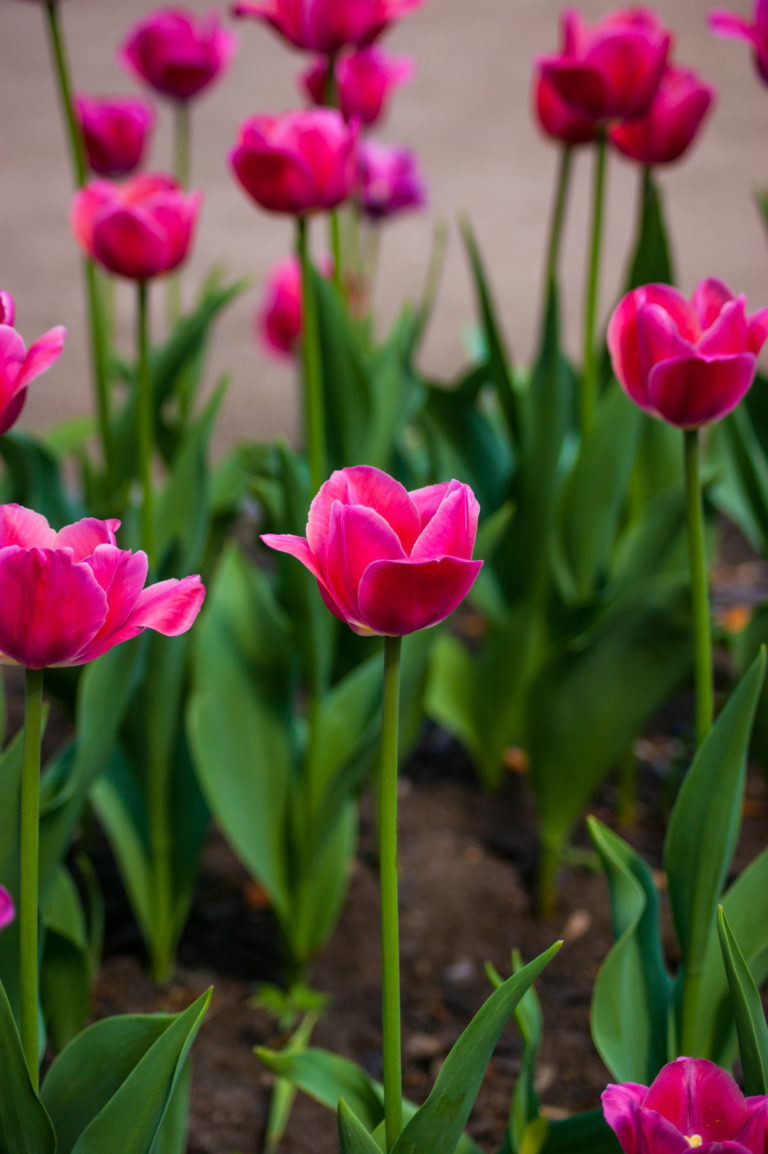
Interesting
- greenish white Ice Age,
- pink Angelique,
- white-red Gerbrand Kieft,
- orange-red Golden Nizza,
- yellow-pink Dream Touch.
- Color Burst has a rich lavender petal color and a yellow center.
on the photo variety of terry late tulip Color Burst
The history of the orange-red variety Gudoshnik Double is unusual: from the old variety, the Artist, a double sport was obtained. Dutch producers simply named it Gudoshnik Double.
Varieties, photo and name of tulips of average flowering time
The second group of plants combines the most common and popular tulips of Darwin and Triumph.
Included in Class 3, Triumph tulips are a composite group of plants with simple large flowers crowning flower stalks up to 70 cm in height. Varieties dating back to the beginning of the last century and new varieties are excellent for mass cultivation. Growers are attracted by the strong flower stalks of tulips and perfectly shape-retaining flowers, shaped like graceful wine glasses. Flowering begins in the last decade of April and lasts 7-12 days.
Due to their size, stable flowering and the presence of not only red, but also yellow, pink tulips, plants with white, deep purple and even two-color corollas, mid-early varieties are recognized by landscape designers, ordinary flower growers and those who are partial to tulips in bouquets. The interest of summer residents in the group is supported by:
- unpretentiousness of varieties;
- versatility of appointment;
- an abundance of colors;
- large flowers that keep their shape and freshness for a long time;
- easy vegetative propagation;
- the ability to use for forcing in the middle and late periods.
Tall, resistant to viral diseases and highly variable due to their tendency to mutation, Darwin's hybrids compete equally with the Triumph tulips and form Class 4, as extensive as the previous one.
These plants owe their popularity to the tulip variety shown in the photo with the name Apeldoorn, which fully demonstrated the ability to produce offspring during vegetative propagation, unlike the parent plants.
Another variety widely known in the territory of the former Soviet Union is the Parade tulip, obtained back in the 50s and still decorating the streets of Russian cities and flower beds of summer residents.
The yellow tulip shown in the photo, closely related to the previous variety, is called Golden Parade and is rightfully considered one of the largest mid-early varieties in the family.
Breeding and distribution
According to the international classification of tulips, Greig tulips belong to the 14th class. The first description of the class was given in the 60s. XIX century. scientist-botanist Regel in St. Petersburg.
At first, these plants were perceived as a kind of Altai tulip, after a few years they became a separate species, they received their name in honor of Samuel Greig, the head of the Imperial Russian Society of Gardening. They quickly gained fame as a first-class variety. In the middle of the XX century. Class 14 tulips have undergone significant adjustments.
The typical habitat of these plants is wild nature, they grow successfully in Kazakhstan, the Netherlands, which are the place of selection of tulips. They grow well in the mountains, on rocky plains, flowers can be found at an altitude of 2500 km above sea level and in the northern regions of our country.
Usage
Greig's tulips are well suited for breeding. Modern summer residents can also plant representatives of the Greig family in groups, combining tall and short specimens.

In Russia, the use of Greig's flowers is varied:
- creation of flower arrangements;
- some of the ideas of landscape designers;
- distillation in February-March - miniature flowers are most suitable;
- decoration of borders;
- gardening of personal plots;
- planting in pots on verandas, balconies;
- in Asian countries, bulbs are used as a pain reliever.
Group of late blooming tulips
The group of late blooming tulips consists of Plain and Double late tulips. Late varieties of tulips are considered Fringed, Lily, Green, Rembrandt and Parrot - they all bloom in the second half of May.
Simple late (grade 5)
The stems that are endowed with simple late tulips are very powerful. The goblet flowers have a square base. The height of strong peduncles that do not need a garter can reach 65-70 cm. The color can be either one-color or two-color. If you combine one of the representatives of this category with any early variety, you can ensure continuous flowering.
The most prominent representative of the variety is the Shirley tulip. Its bud is ivory colored. There are also bright lilac touches and edging. Another original copy is Queen Of Night. This maroon flower has a velvety texture. It is an irreplaceable item in the preparation of bouquets.
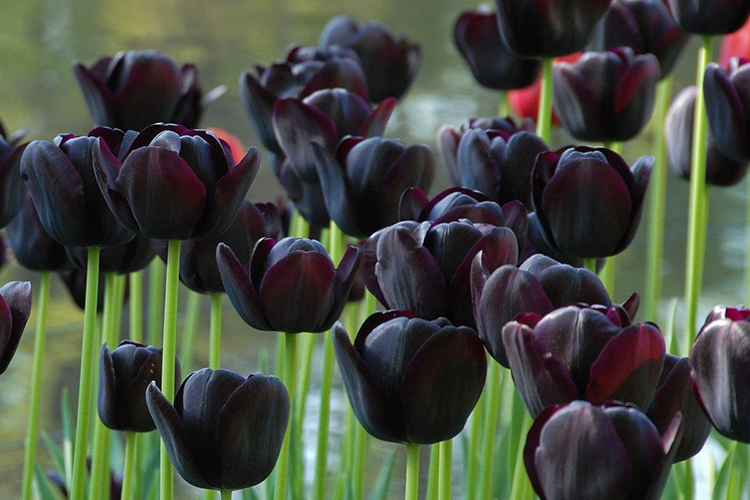
Lily flowers (grade 6)
Lily-colored tulips are usually crimson, red, yellow, pink, white, and can also be two-colored. The height of a strong peduncle reaches 55-60 cm. The color inside the flower is somewhat different from the outside. Usually the flower opens completely. The most popular varieties in this class are Ballada, which has graceful dark purple flowers with light edges, and the easy-care Carmine Pretty Woman.
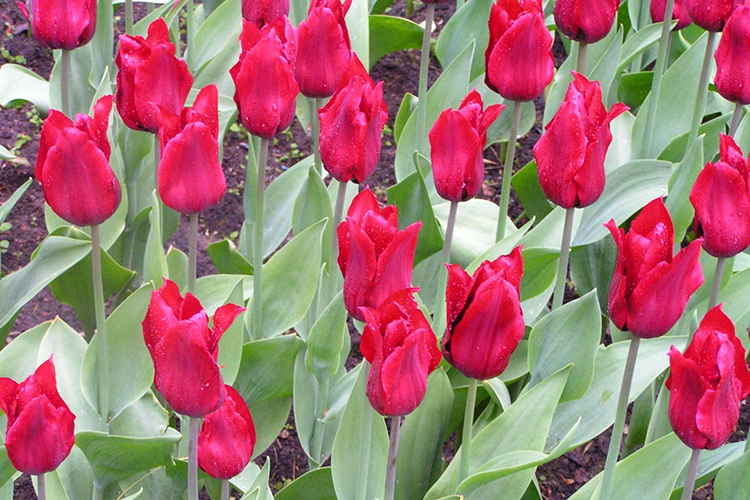
Fringed (grade 7)
The edges of the petals of fringed tulips are decorated with a needle-like fringe. The peduncle can reach a height of 80 cm. The color is different - from purple to white.One of the most prominent representatives of this class is the Gusto variety. Its buds are colored red-orange, and there is a yellow fringe along the edges of the petals. Another original Cambridge variety, milky white, endowed with a very thick and large fringe. During forcing, the color of this flower is snow-white.
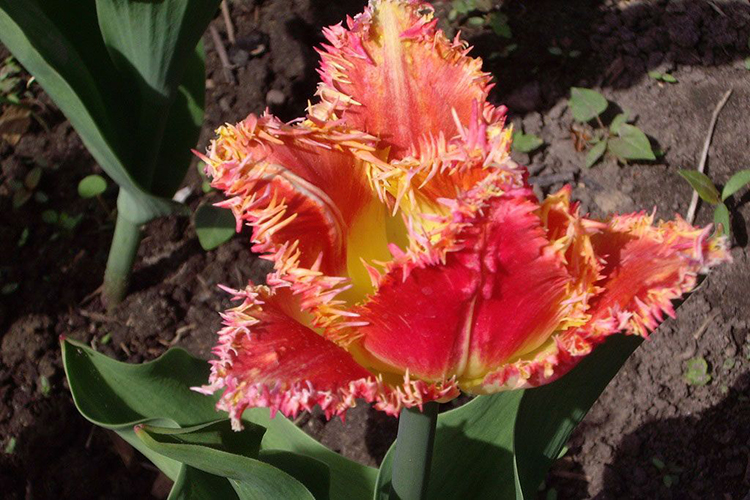
Green-colored (grade 8)
Green tulips are rare. They differ from other species by the presence of petals, which are decorated with a green center. In this case, the edges of the petals are yellow, pink, or white.
The cream-colored flower bud of Florosa becomes soft pink at the bottom upwards. When composing compositions, a green back gives an exotic flower.
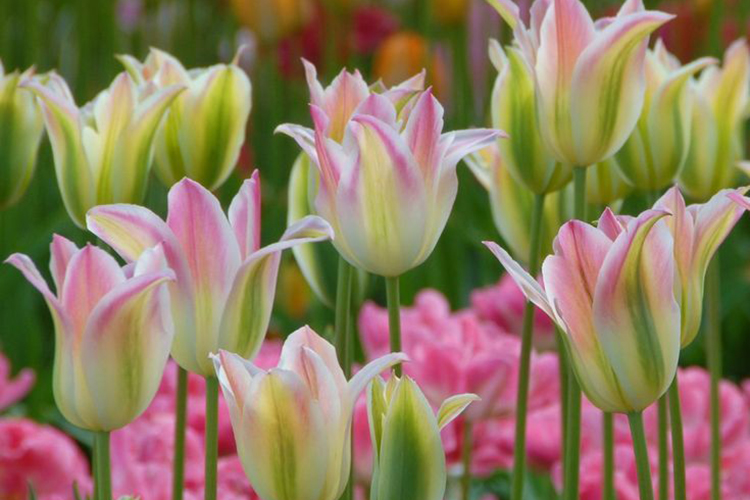
Rembrandt tulips (grade 9)
Varieties of the Rembrandt tulip class are distinguished by their variegation and unusual color. Often, the petals have different stripes or strokes, and the red, white and yellow colors are unusually combined. The peduncle can reach a height of 70 cm. These varieties are often grown for cutting.
Among the most popular are Princess Irene of a delicate peach color with burgundy strokes on the petal, as well as the goblet-shaped Sorbet variety, distinguished by snow-white large flowers with well-defined strokes.

Parrot (grade 10)
The exoticism and uniqueness of parrot tulips is their main advantage over other species. These flowers cannot be confused with others because of the wavy petals with cut and bent back edges and bright variegated color. The buds are large, have a goblet shape. Peduncle height can reach 65 cm.
One of the popular varieties is Black Parrot (Black Parrot). The buds of this flower are lush, painted black and have a bluish bloom. It is used when drawing up bouquets, but it looks most effective in group plantings.
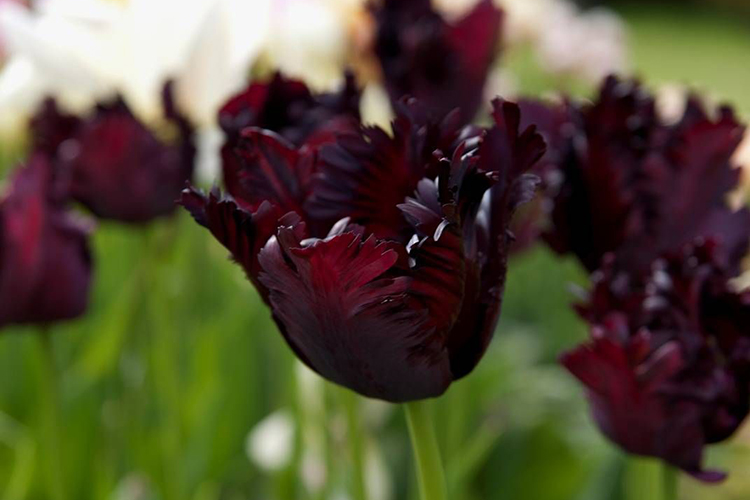
Terry late (grade 11)
Terry late varieties are characterized by large flowers and late flowering. The color of the buds is usually solid or black and white. The bulbs should be planted out of the reach of the wind.
A popular late tulip cultivar is the bright yellow Double Beauty of Apeldoorn flower adorned with red touches. The buds of some specimens are visually halved by the color.
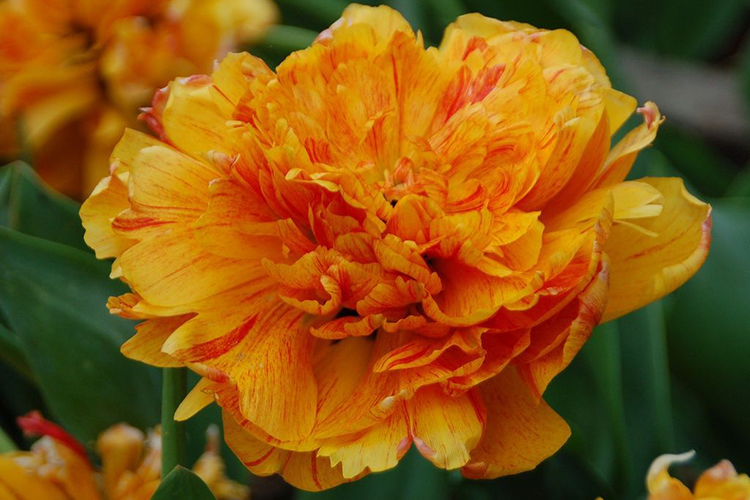
Types of tulips and their hybrids
The group has an unusual name, all because all the flowers that did not fall into the previous classes were assigned here. There are a lot of varieties here. We will name the main types of tulips, look at their photos. There are only four names, but there is a wide variety of flowers themselves, since breeders mix them with each other. Tulips are different, the flowering time can be both early and late. Of course, the varieties are also different in appearance.
Kaufman
As a rule, they are pleased with flowering already in April. Flowers are undersized, ideal for decorating borders, can be grown in trays on summer verandas. The shape of the inflorescences resembles a star. They can decorate rockeries, alpine hills, they are not afraid of shadows. These tulips are crossed with the next two and get different hybrids. The class was bred in 1877.
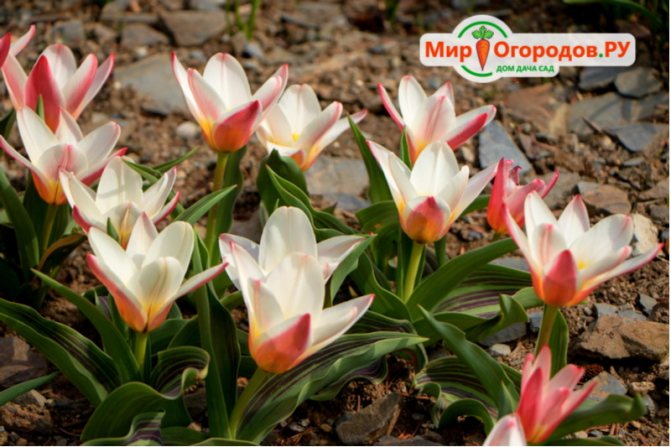
Foster
Tulips are large - up to 15-18 cm in diameter. They bloom in spring, they are often planted in composition with other primroses or flowers that open their buds in early summer. Shades of petals can be different, varieties are not afraid of frost. In culture since 1905.

Greig
Most often, tulips have either two shades on one flower, or they are just red. Ideal for decorating paths, can be planted at the base of the rock garden. Inflorescences are large, unpretentious class with strong stems. The petals have jagged edges. The class is used for crossing with Kaufman and Foster tulips. In culture since 1872.

Wild
These tulips have also been classified, but many varieties are quite unremarkable when compared to other groups. It is worth noting that the three classes listed above are also classified as wild - Kaufman, Foster, Greig.The group also includes tulips - "Borshcheva", "Alberta", "Velikie", "Tubergena", "Julia" and a number of other varieties. Not all flowers surprise with shades, saturation, petals can be small in size. But on the other hand, these tulips are absolutely unpretentious, that's why they are wild. They can bloom up to a month in time. Breeders use wild varieties to create new hybrids.


